10 Surprising Facts About Keeping Your Drains Clog-Free
By Brian on July 24, 2025
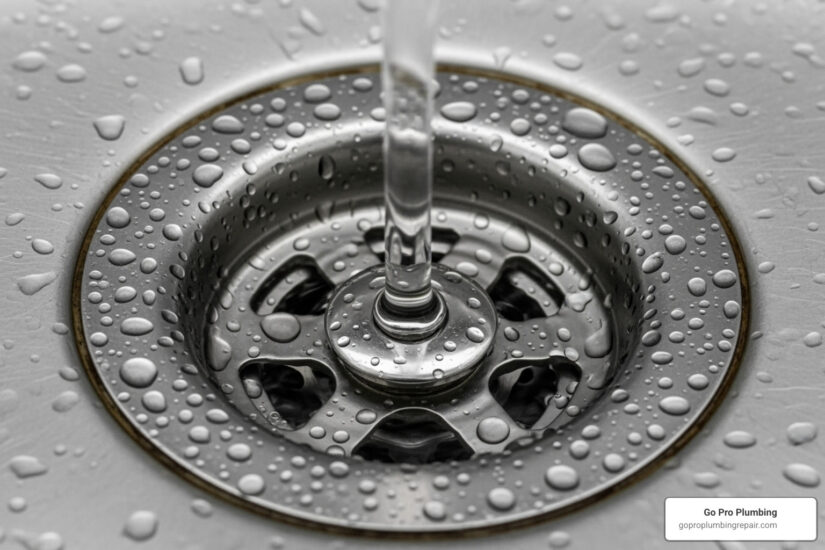
Why Clear Drains Matter
Drain cleaning is the process of removing blockages and buildup from plumbing pipes to restore smooth water flow and prevent future problems.
The main approaches include:
- DIY Methods: Plungers, natural remedies, or small hand snakes for minor clogs.
- Chemical Cleaners: Store-bought solutions that can dissolve some clogs but risk pipe damage.
- Professional Services: Specialized tools like powerful drain snakes, hydro-jetting, and camera inspections for stubborn issues.
A clogged drain is frustrating, with gurgling sounds, slow drainage, or complete backups disrupting your daily routine and risking costly repairs if ignored. Understanding your home’s plumbing can save you headaches and money.
This guide shares 10 surprising facts to help you keep drains clear, prevent issues, and know when to call a professional.
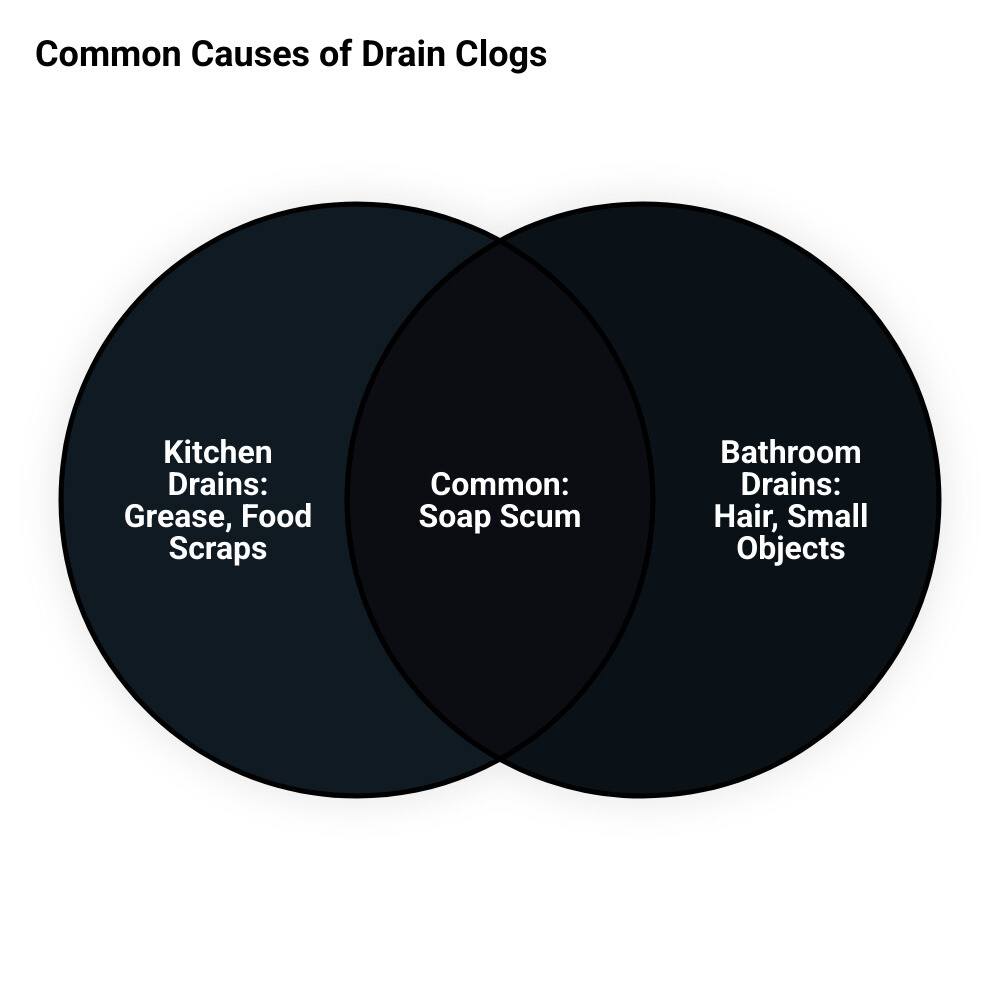
Simple drain cleaning glossary:
The Hidden Culprits: What Really Clogs Your Drains
Understanding the hidden enemies of your drains is the first step to keeping your pipes clear and water flowing freely.
Fact #1: Grease Doesn’t Just “Wash Away”
It’s a common myth that hot water washes away fats, oils, and grease (FOG). When hot FOG enters cooler pipes, it solidifies and clings to the pipe walls. Over time, this sticky residue builds up, narrowing the pipes and causing stubborn blockages. Food scraps, rice, pasta, and coffee grounds get trapped in the greasy buildup, making the clog worse. The Environmental Protection Agency warns that FOG is a major cause of sewer overflows.
To prevent this, always scrape plates into the trash before washing and pour used cooking grease into a sealed container for disposal, not down the sink. This simple step is crucial for preventing the need for drain cleaning.
If your kitchen sink is giving you grief, our guide on how to Clean Out Sink Drain can offer some helpful tips.
Fact #2: Hair and Soap Scum Form Nasty “Super-Clogs”
In the bathroom, hair is a primary culprit for clogs. It doesn’t dissolve and easily snags inside pipes. Hair then combines with soap scum—the filmy residue from soap reacting with hard water—to form tough “super-clogs.” This sticky combination acts like glue, binding hair and other debris into a dense, tangled blockage.
A slimy layer of bacteria called biofilm adds to the stickiness, trapping even more debris. The result is often a slow-draining shower or tub, which can lead to unpleasant odors and backups. Recurring clogs and sluggish drains are common complaints from this hairy, soapy mess.
Fortunately, prevention is easy. Use a simple drain screen or hair catcher to stop hair from entering your pipes. This small effort can save you from a major drain cleaning headache later on.
If your bath drain is putting up a fight, our tips on how to Unblock Bath Drain might be just what you need.
The DIY Dilemma: Home Remedies and Safe Tools
When a drain slows, many people reach for a quick fix. It’s crucial to know what works, what doesn’t, and what could make things worse. Understanding your limits is key to effective drain cleaning.
Fact #3: A Kitchen “Volcano” is a Gentle, Eco-Friendly First Step
The baking soda and vinegar method is a gentle, eco-friendly first step for minor clogs and odors. First, pour a pot of boiling water down the drain to loosen grease. Follow with a cup of baking soda, then a mixture of one cup of water and one cup of vinegar.
When baking soda (a base) and vinegar (an acid) combine, they create carbon dioxide gas. This fizzing action helps loosen minor clogs and residue. It’s particularly effective for smelly drains or slow pipes caused by grease or soap scum. This method is safe for your pipes and septic system, avoiding harsh chemicals. While it won’t clear severe clogs, it’s an excellent first line of defense.
For more gentle solutions, explore our advice on the Best Thing To Unblock Drains.
Fact #4: Store-Bought Chemical Cleaners Can Damage Your Pipes
While tempting for a quick fix, we as plumbing professionals advise against using chemical drain cleaners. They can cause more harm than good. These cleaners contain powerful caustic agents or oxidizing agents that generate intense heat to dissolve clogs.
The problem is, they don’t just dissolve the clog; they can also corrode and damage your pipes, especially older PVC or cast iron pipes. This can lead to leaks and expensive pipe failure over time. If the cleaner fails to clear the clog, it can sit in your pipes, creating a corrosive pool that eats away at the pipe material.
Beyond pipe damage, these chemicals pose health risks. They can cause severe burns, and their fumes can be toxic. They are also harmful to the environment. Their long-term effectiveness is limited, as they rarely provide a thorough drain cleaning. The risks far outweigh the convenience.
Learn more about the safety of these products in our article, Are Commercial Drain Cleaning Products Safe?.
Fact #5: DIY Tools Have Their Limits—Know When to Call a Pro
DIY tools like plungers and hand snakes can be effective for minor, close-to-the-surface clogs, but know their limitations.
- Plungers: Use a vacuum and water pressure to dislodge clogs. They work well for toilets, sinks, and tubs.
- Hand Snakes/Augers: These flexible cables have an auger at the end to break up or pull out clogs. They are typically used for smaller drain lines (1 1/4 to 2 inches) and can reach 25 to 50 feet. Toilet augers are specially designed to steer the toilet’s trap without scratching it.
However, these tools are only effective for nearby clogs. They cannot clear blockages deep in your main sewer line, remove tree roots, or thoroughly clean pipe walls. Improper use can push a clog deeper or scratch your pipes, creating spots for future clogs to form.
If a clog is stubborn or keeps recurring, it’s time to call the professionals. We have the specialized equipment and expertise to resolve blockages safely and efficiently.
For more on these tools, read our guide on the Drain Plumbing Snake.
When to Call the Pros: Advanced Drain Cleaning Solutions
Sometimes, a clog is a symptom of a larger problem. Recognizing the warning signs and understanding advanced professional tools can save you from costly emergencies.
Fact #6: Gurgling Noises Are Your Pipes Crying for Help
Your plumbing system sends distress signals before a major problem occurs. Recognizing these signs can prevent a plumbing emergency. Be alert for these red flags:
- Gurgling Sounds: If you flush a toilet and hear a gurgle from a shower drain, it means air is trapped by a blockage.
- Recurring Clogs: A clog that keeps coming back points to a deeper issue.
- Multiple Slow Drains: If several drains are sluggish, the problem is likely in your main sewer line.
- Foul Odors: Unpleasant smells often indicate decaying buildup or a sewer line problem.
- Water Backups: Water backing up into sinks or tubs is a sign of a major blockage that needs immediate professional attention.
Ignoring these warnings can lead to burst pipes, water damage, or sewage backups. It’s always best to call the pros when your pipes start sending these signals.
For immediate assistance with these kinds of urgent issues, remember our Sewer And Drain Emergency Services are here to help.
Fact #7: Plumbers Use Cameras to See Exactly What’s Wrong
Modern drain cleaning technology allows plumbers to see inside your pipes without excavation, eliminating guesswork.
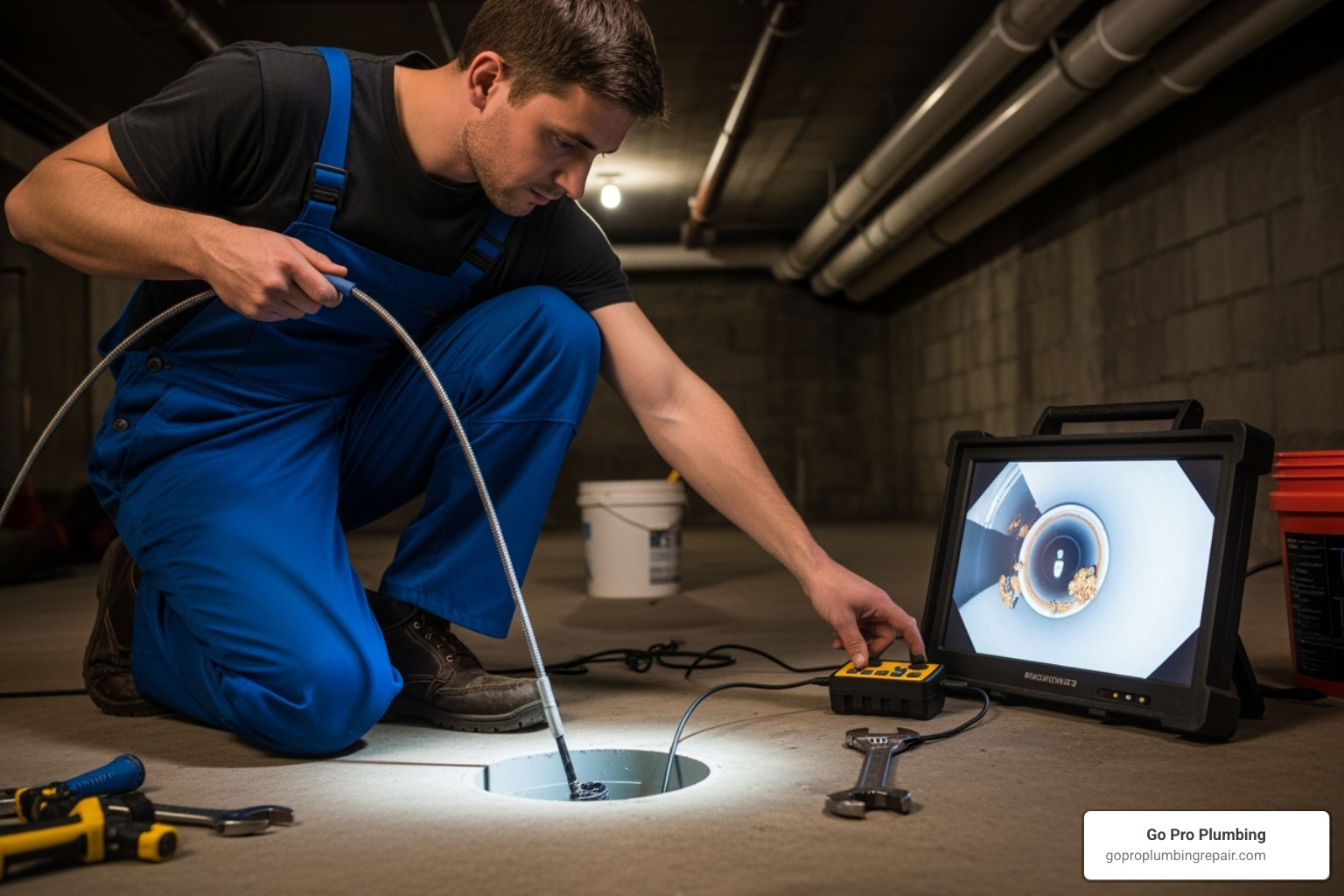
We use a small, high-resolution camera on a flexible cable, which is fed into your drainpipe to send live video to a monitor. This allows us to pinpoint the exact location and nature of the problem, whether it’s a hairball, grease buildup, a foreign object, or invasive tree roots.
Cameras are also useful for identifying pipe damage like cracks, corrosion, or collapsed sections. For new homebuyers, an inspection can spot potential issues before purchase. Our cameras can inspect pipes from 3 to 10 inches wide and reach up to 200 feet, providing a comprehensive view of your drainage system. This technology ensures accurate diagnosis and efficient clearing, saving time and money.
To get a clear picture of your main lines, check out our Sewer Line Services.
Fact #8: Hydro-Jetting is Like a Pressure Wash for Your Plumbing
For tough, recurring clogs, plumbers use hydro-jetting—a powerful drain cleaning method that acts like a pressure washer for your pipes.
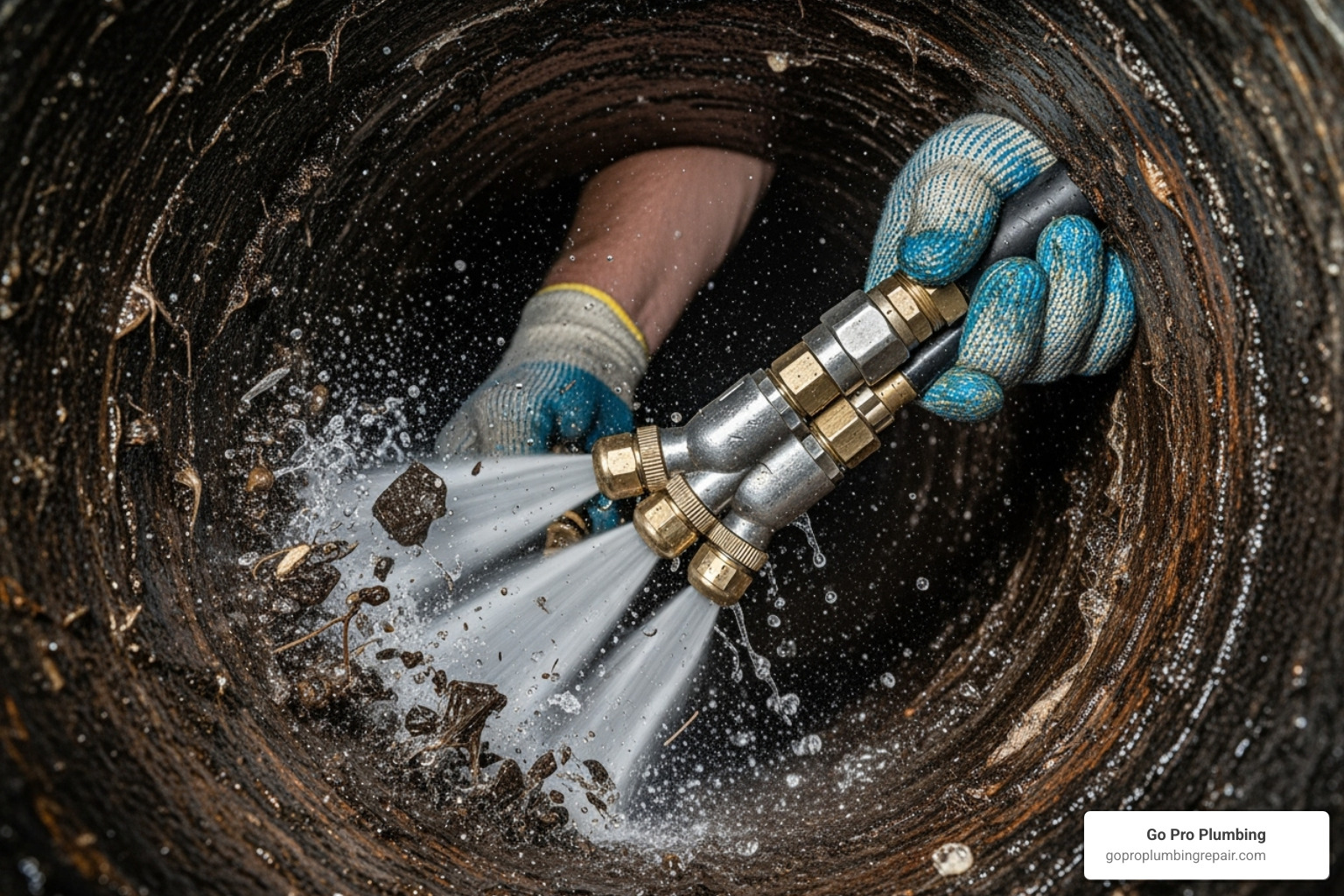
Hydro-jetting uses water streams up to 4000 pounds per square inch (psi). A special nozzle is inserted into the pipe, blasting away stubborn blockages and buildup. While a traditional snake might punch a hole through a clog, hydro-jetting thoroughly cleans the entire inside surface of the pipe.
It is highly effective at removing:
- Grease buildup
- Scale and mineral deposits
- Invasive tree roots
- Sludge and debris
The result is a pipe that’s nearly as clean as new, restoring optimal flow and reducing the chance of future clogs. Hydro-jetting is a comprehensive drain cleaning solution that removes not just the blockage, but the residue that causes future problems.
To dive deeper into this powerful method, take a look at our page on High Pressure Sewer Jetter.
The Ultimate Guide to Clog Prevention
Now that we’ve covered the causes and cures for clogs, let’s focus on the best strategy: prevention. A little proactive effort can save you the frustration and expense of clogged drains.
Fact #9: Your Garbage Disposal Isn’t an Invincible Trash Can
A common misconception is that a garbage disposal can handle any waste. In reality, they are designed only for small amounts of soft food scraps and have significant limitations. Putting the wrong items down your disposal can lead to serious blockages.
Avoid putting these down your disposal:
- Fats, oils, and grease (FOG): They solidify and coat pipes.
- Fibrous vegetables: Celery, asparagus, and onion skins can wrap around the blades.
- Bones and fruit pits: They are too hard for the disposal to grind.
- Coffee grounds and eggshells: They accumulate into a thick sludge.
- Pasta and rice: They expand with water and create starchy blockages.
To use your disposal properly, always run cold water before, during, and for 30 seconds after grinding. Cold water helps solidify fats so they can be chopped up and washed away. When in doubt, throw it out!
For more tips on keeping your pipes clear, check out our guide on how to Clean Out Drain Pipe.
Fact #10: The Benefits of Professional Drain Cleaning Go Beyond a Single Clog
The true secret to a healthy plumbing system is prevention. The benefits of professional drain cleaning extend far beyond removing a single blockage to ensuring long-term pipe health.
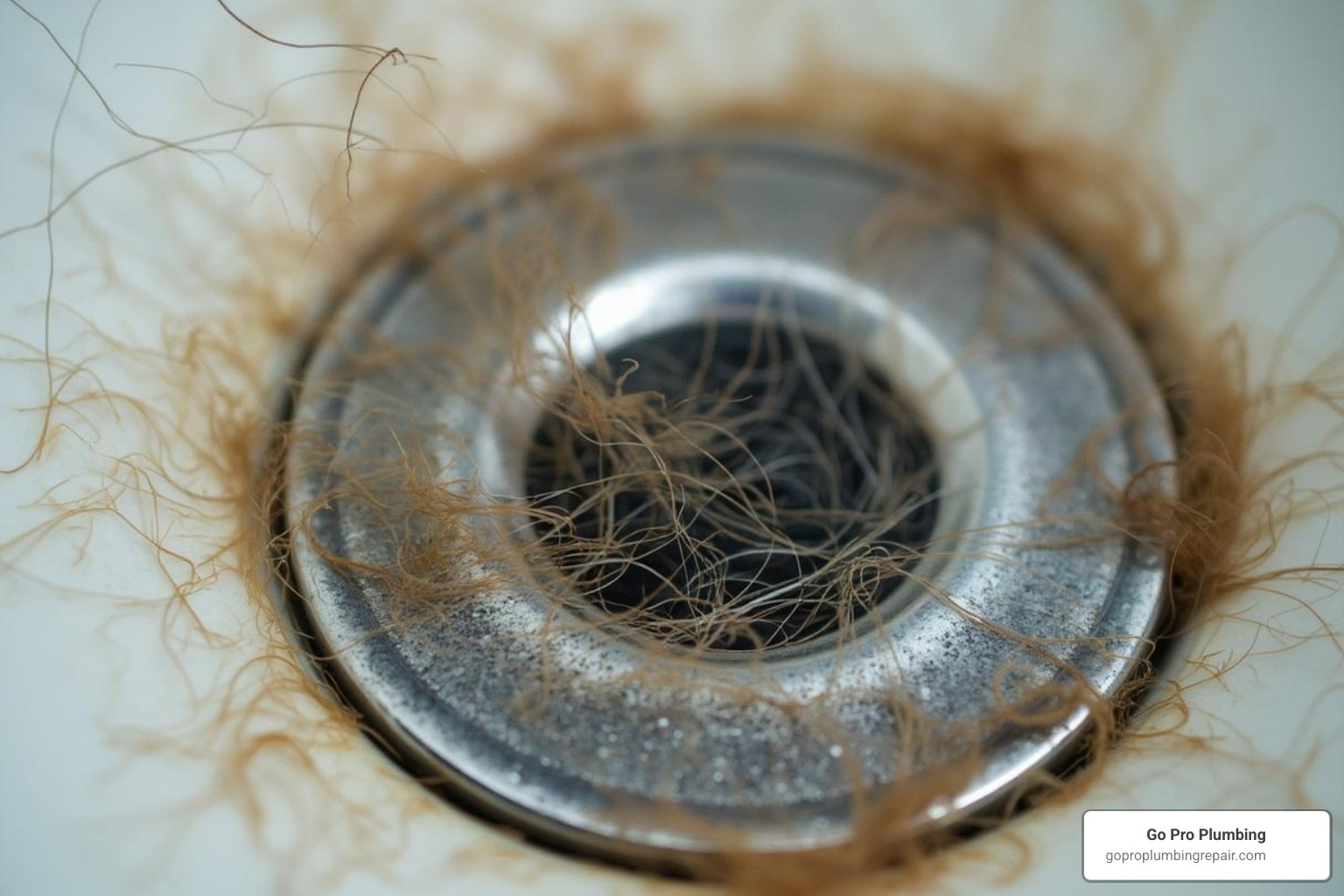
Here’s why prevention is key:
Simple home habits make a big difference. Use drain screens to catch hair and food particles. Scrape plates before washing to keep grease and scraps out of the sink. Regular hot water flushes can help wash away minor buildup. And as we’ve learned, it’s best to avoid chemical cleaners that can harm your pipes.
For ultimate peace of mind, schedule routine professional cleanings. This is a vital part of home maintenance. While stoppers and catchers help, buildup from soap and other materials will eventually make professional drain cleaning necessary.
Professional drain cleaning, especially with methods like hydro-jetting, scours the entire pipe, removing the sticky residue that causes future blockages. This proactive approach extends the life of your pipes and prevents stressful emergencies. It’s an investment in the reliability of your home’s plumbing.
Understanding the benefits of professional intervention can save you time, money, and a lot of stress in the long run. Learn more about the value of this service on our page about the Benefits Of Professional Drain Cleaning Services.
Frequently Asked Questions About Drain Maintenance
Here are answers to some of the most common inquiries we receive about drain cleaning and maintenance.
What’s the difference between drain snaking and hydro-jetting?
Snaking and hydro-jetting are two professional drain cleaning methods that work differently.
Drain snaking uses a long, flexible cable with an auger head to drill through or hook onto a blockage. It’s effective for clearing immediate obstructions like hairballs or foreign objects. However, snaking often just punches a hole through the clog, leaving residue on the pipe walls.
Hydro-jetting is a more comprehensive cleaning method. It uses a high-pressure water jet (up to 4000 psi) to scour the entire interior surface of the pipe. It removes not only the main clog but also all the grease, scale, and buildup clinging to the pipe walls, providing a much more lasting solution.
How often should I schedule professional drain cleaning?
The ideal frequency for professional drain cleaning depends on several factors, including your household’s usage, the age of your pipes, and any past issues with clogs or tree roots. If you have a busy household, older pipes, or a history of recurring clogs, more frequent cleaning is beneficial.
As a general guideline, we suggest an annual professional drain cleaning for preventative maintenance. However, if you notice warning signs like slow drainage, gurgling noises, or foul odors, don’t wait. Addressing issues promptly can prevent them from escalating into larger, more costly problems.
Are chemical drain cleaners ever a good idea?
We generally do not recommend chemical drain cleaners due to their significant downsides. While they may offer a temporary fix, the risks are high.
Here’s why we advise against them:
- Pipe Damage: The harsh chemicals can corrode or melt pipes, leading to expensive leaks and repairs.
- Health Hazards: They can cause severe chemical burns, and their fumes are toxic if inhaled.
- Environmental Impact: These chemicals are harmful to the environment as they enter water systems.
- Limited Effectiveness: They often only clear a narrow path through a clog, meaning the problem is likely to return quickly.
For minor clogs, natural remedies like baking soda and vinegar are a safer choice. For anything more stubborn, calling a professional is the safest and most effective solution for your pipes and your health.
Conclusion: Keep Your Drains Flowing Freely
Now that you’ve learned these facts about your home’s plumbing, you’re equipped with the knowledge to keep your drains happy and flowing freely.
The key takeaways are simple:
- Prevention is paramount. Being mindful of what goes down your drains and using tools like drain screens can prevent most clogs before they start.
- Know your DIY limits. Home remedies and plungers are great for minor issues, but stubborn or deep clogs require professional tools to avoid making the problem worse.
- Professionals offer a complete solution. With advanced tools like camera inspections and hydro-jetting, plumbers can diagnose the exact problem and provide a thorough cleaning that protects your entire plumbing system.
At Go Pro Plumbing, we understand how frustrating a clogged drain can be. We are committed to providing outstanding customer service and same-day service to our neighbors in Northern California, including Rancho Cordova and Sacramento. Our expert team uses state-of-the-art diagnostic tools and effective solutions to get the job right the first time. Our goal is to ensure your drains flow freely, restoring peace and comfort to your home.
For comprehensive and professional drain cleaning services that truly protect your home’s plumbing, don’t hesitate to reach out.
